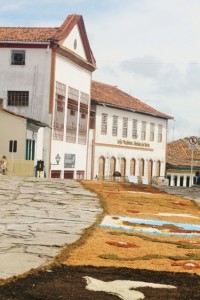
Photo © Michael Sommers.
For years now, one of the Brazilian spectacles I’ve longed to witness are the “tapetes de serragem” (sawdust carpets) that decorate the streets of a handful of Minas Gerais´ colonial towns during the major Catholic religious festivals of Easter and Corpus Christi.In fact, it was to satisfy this long-held desire that I purposely booked my recent trip to Diamantina to coincide with the beginning of the Semana Santa (Holy Week) festivities that culminate in Easter.
In terms of population, Brazil is the largest Catholic nation on the planet.In terms of population, Brazil is the largest Catholic nation on the planet. However, many Brazilians who self-identify as Catholics practice Catholicism only nominally. Others practice syncretic forms of Catholicism that have, over the centuries, fused with elements of African and indigenous cults (particularly in the North and Northeast). Meanwhile, in recent years, Catholicism has steadily lost ground to the successful expansion of neo-Pentecostal churches.
However, Catholicism still runs deep in the cidades históricas (historical cities) of Minas Gerais that sprang up during the region’s epic 18th-century gold and diamond rushes. It is estimated that more than half of the world’s gold supply – not to mention a serious portion of it diamonds – was hidden in the rivers and mountains of the area that came to be known as Minas Gerais (“General Mines”).
As fortune seekers poured in from all over Brazil and Portugal, hundreds of thousands of slaves from neighboring Bahia as well as Africa were brought in to work the mines in towns such as Ouro Preto, Mariana, São João del Rei, and Diamantina. Also looking to get in on the action were a host of religious orders, who settled in these towns and sparked the construction of magnificent baroque churches whose interiors were lavishly plastered in gold donated by the nouveau riche as grateful offerings to the patron saints whose divine intervention helped them strike it rich.
Over the centuries, the power of these orders has remained strong as has the splendor of the churches and the festivities that commemorate important dates on the Roman Catholic calendar. Many traditions have their roots in Portuguese celebrations, but were infused with elements of Brazilian baroque which developed in Minas Gerais and still hold sway.
The tapetes de serragem are a case in point. The tradition of paving procession routes with intricate mosaic murals of holy motifs (doves, crosses, hearts) fashioned has its origin in the Azores, but migrated to Minas Gerais in the early 1700s. Although originally the carpets were made from dyed sawdust, more recently other materials such as sand, flour, egg shells, and coffee grounds have been added to the mix (in Mariana, citizens begin saving up their coffee ground a year in advance). Additional texture is sometimes provided courtesy of flower petals, leaves, and even bottle caps.
Diamantina’s tapetes, however, are strictly sawdust. Months in advance, wood chips and shavings are dyed and subsequently distributed among large sacks according to hue and texture. Then, beginning at midnight on Saturday, residents take to the cobblestoned streets of the historical center and begin laying down the mosaic carpets upon which Easter Sunday’s costumed procession reenacting the Resurrection of Christ will travel.
When, armed with my camera, I arrived on the scene at 9 am, the cobblestones of the previous night had been magically transformed into rivers of color. In front of the Catedral Metropolitano, a marching band was tuning up while a cast of winged angels and Biblical figures stood in clusters, waiting for the procession to begin.
Hoping for solitary untrampled access to the tapetes, I set off in advance down Diamantina’s version of the yellow brick road. Struck by the sensation that I was walking in a dream, I followed the carpet as it veered up and down steep hills and swerved around tight corners, passing whitewashed houses whose open windows were draped with embroidered fabrics that fluttered in the wind like flags.
The sawdust mosaics seemed so delicate that I was surprised to see residents and tourists alike rather nonchalantly stepping over the carpets to cross from one sidewalk to another. In fact, despite half expecting to be arrested or struck down by lightning, I couldn’t resist gingerly stepping on the tapetes a few times myself.
I’m glad I did. On Monday, when the streets were back to normal, aside from photos I took, I was pleased to find a few stray strands of colored sawdust lingering on the sole of my shoe, reminding me that the tapetes de serragem hadn’t just been a dream.